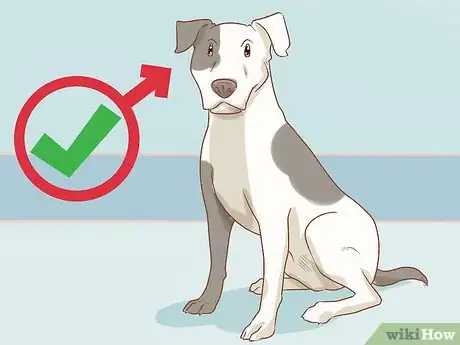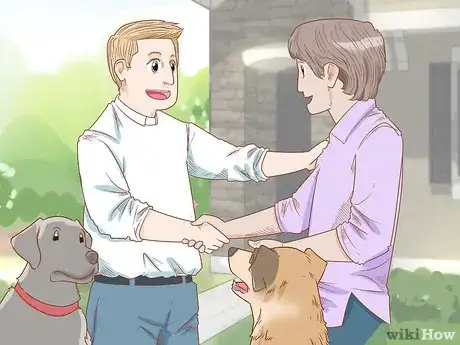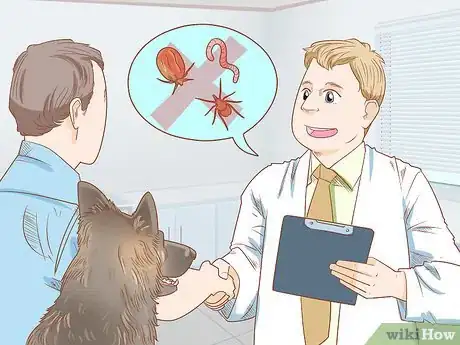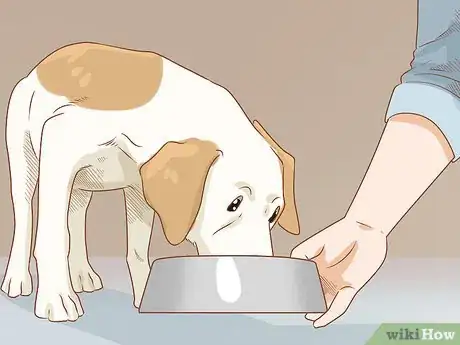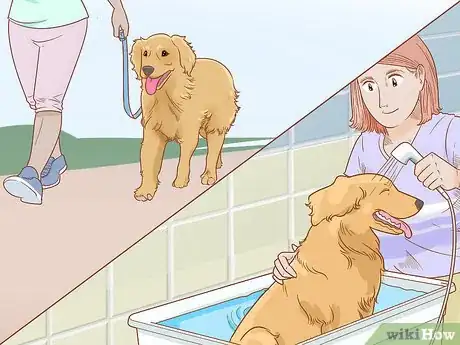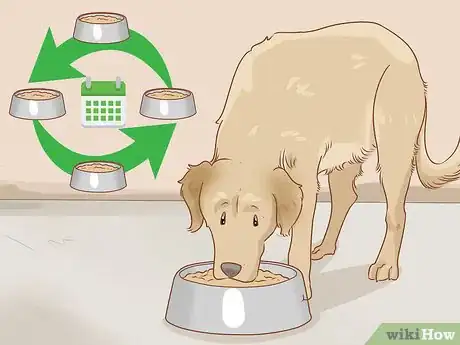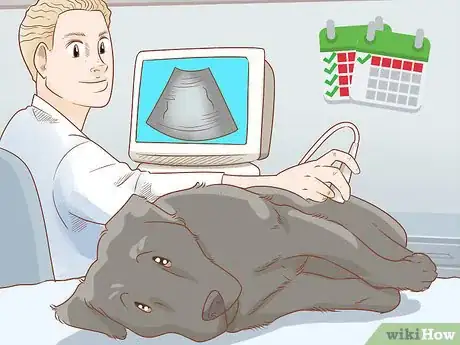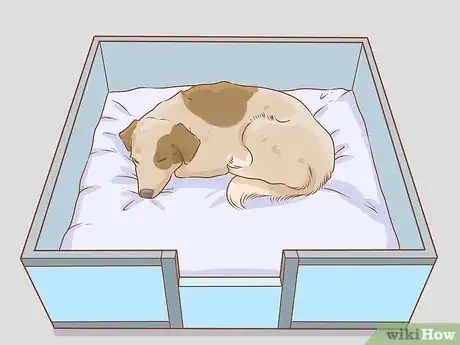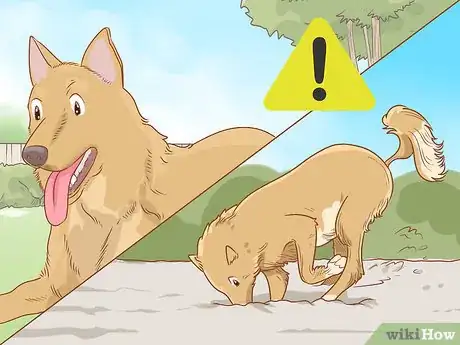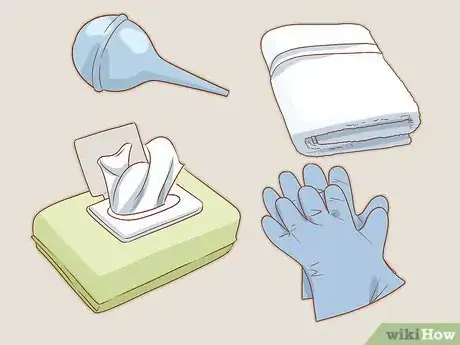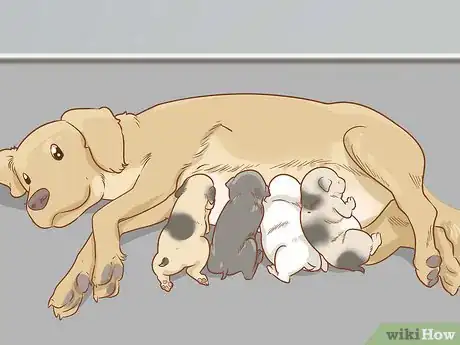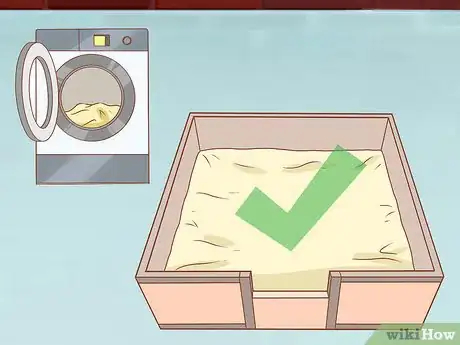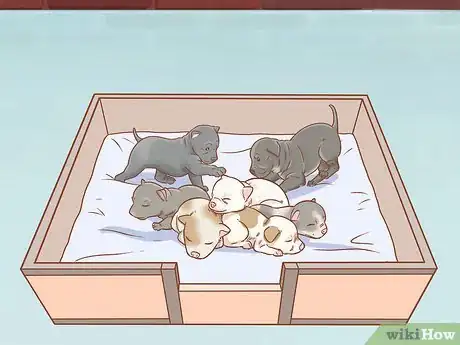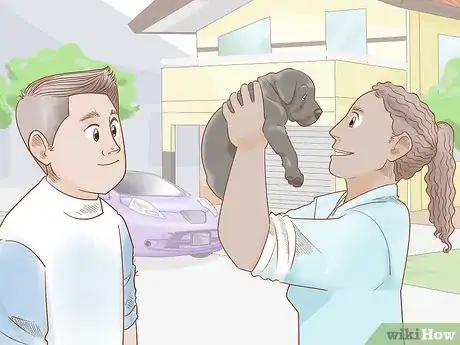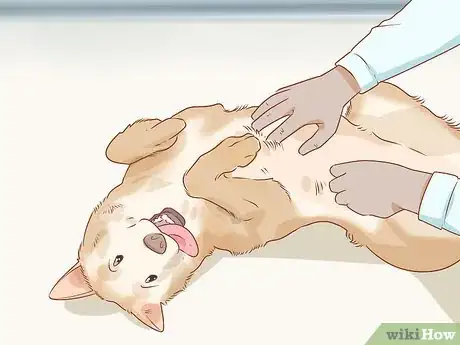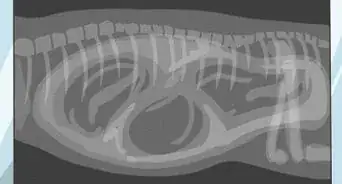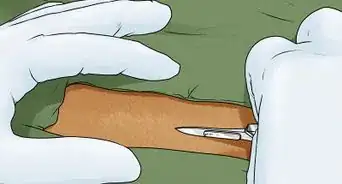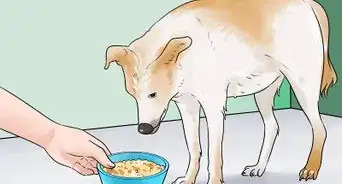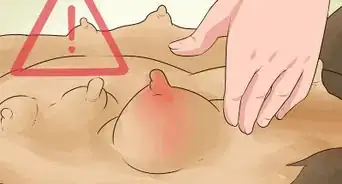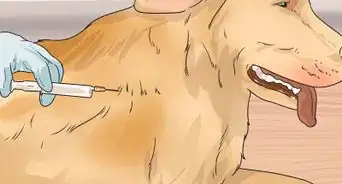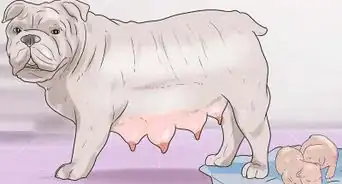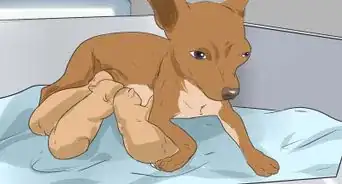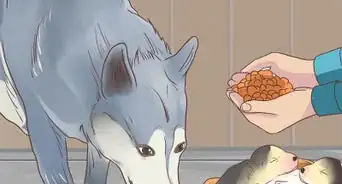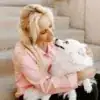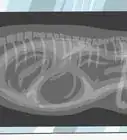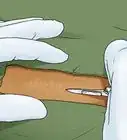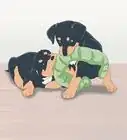This article was co-authored by Natalie Punt, DVM. Dr. Natalie Punt is a Veterinarian and the Founder and CEO of mPet- a smart phone app for pet owners to store, manage and transfer their pets medical records and health information. She specializes in small animal emergency and general medicine and veterinary practice economics. Dr. Punt holds a BS in Biochemistry and Molecular Biology from The University of California, Davis, an MS in Biochemistry from The University at Buffalo, and a DVM from Western University of Health Sciences.
This article has been viewed 21,086 times.
Is your dog expecting puppies? Have you just started the whole breeding process? There is a lot of information that you will need to know about breeding. This article contains helpful information and tips when it comes to the lovely world of dogs! Enjoy!
Steps
-
1Make sure you have an eligible stud dog lined up to be the father of the puppies. The stud dog should be no bigger than the female as this could cause complications during labor. You can find a stud dog through breeders in your local area, at dog parks, vets, social networking sites, and other social events.
- It should be noted that breeding dogs should be left to breeders (not puppy mills) and not done in the back yard. This is bad for everyone.
-
2Once you have found your stud dog and have been through all the arrangements with the owner such as what the price will be, will your dog stay at the stud's house, has the stud dog met up to all of the necessary standards and has his been health checked. If yes, then it is time to find out when your female is ready to mate.Advertisement
-
3Before breeding, have your female vet checked for parasites, worms, and other health problems that could prevent a healthy pregnancy.
-
4Once you have had both dogs checked, it is time to breed. Your female will go into an estrus cycle (known as heat) usually 2 times a year, though large breeds may only go into heat once a year. During heat, a female's "bottom" will start to swell and in the next couple of days after this swelling, blood may appear. Wait 10 days after this period then allow the male and female to breed as this is prime breeding time.
-
5Once they have been bred, look for signs of pregnancy. This includes a decrease or increase in appetite, more affectionate, vomiting (also known as morning sickness), lack of energy and her nipples may start to become more visible.
-
6Once you know that she is pregnant you can start to feed her on high-quality puppy food. Puppy food is a great source for protein and other important vitamins and minerals that your dog will need through the pregnancy but also her puppies inside her will need to keep up their strength and help with growth development.
-
7Make sure your dog stays as healthy as possible throughout the pregnancy. This means having fresh, clean water available every day, getting regular exercise, and grooming if required, though she should already have access to all these things.
-
8The gestation period can be between anywhere from 56- 63 days so be prepared! During the next couple of weeks your dog should have an increase in appetite. You should gradually split her food up into 4 separate meals a day as this will make it easier to digest- especially with all those little puppies taking up so much room! Her exercise should remain the same until around week 4 when you should be slowing it down to a gentle stroll up and down the road.
-
9At week 5 you can go into the vets and have an ultrasound done. This is a good idea as it tells you how many puppies to expect and to detect any complications that may arise such as if a puppy might be in a difficult position or is too big to pass through.
-
10As the weeks go by your dog will start " nesting". This is a natural instinct, she is trying to find somewhere to give birth and raise her pups in. But unless you want her giving birth under your bed you might want to start thinking about a whelping box. This is an enclosed area where the mother dog will raise her puppies. It should be double the size of your dog when it is lying down. There should be an area with toys, blankets, etc for the pups and mother but a separate, closed-off area as well where only the mother can access it. This private section could be where you feed her and give her water.The whelping box should be small enough for the mother to jump in and out without any stress but tall enough to keep naughty little puppies from climbing out!
-
11The due date is coming closer! By the last week or so you should start frequently taking the dam's temperature. Her normal temperature should be 100-101 so when it drops to 99-98 you know that labor will begin in 12-24 hours. She will begin to show signs of labor by panting, shivering, and digging.
-
12Here are some things that you will need prior to labor. Plenty of towels, a nasal aspirator, gloves, wet wipes, food and water for the mother, scissors to cut umbilical cords, KY jelly, weight scale, notebook and pen, a good book and lots of COFFEE as this is a very long process.
-
13Once she stops digging around and seems calm this is known as full labor. This is when she will begin contracting and expelling the puppies. When a puppy is emerging you will see a dark kind of bubble appear. This is the puppy, it's head will usually be the first thing you will see but if his legs are coming out first this is known as a breech. If the female is pushing hard but the puppy will not move then you will have to step in. With gloves, wipe KY jelly all around the area and try to grab as much of the puppy as possible. If you can try to grab the tail and not the legs as this will cause less damage to the puppy. Once out the puppy will be enclosed in a sack, if the mother does not remove this sack within a minute you must immediately remove it as it is suffocating the puppy and he needs to breathe. To remove it, at the head of the puppy grab the sack with your fingertips and peel down. After that aspirate the puppy remembering to clear the nose first then the mouth.
-
14When the puppy is cleaned up and breathing give it back to mother to suckle. Suckling is a good way for mother and puppy to bind but it also helps bring on more contractions. Once your dog starts contracting again, remove the puppy from the mother and put it in a separate box. This box should only have enough room for the little puppies to move around in and lie down. Make sure it is very warm and clean! Keep the puppies in here whenever mum is in the process of delivering puppies as it helps keep the puppies safe from mum as she might roll over onto them when she is delivering a puppy but also to warm the pups up and let them sleep.
-
15Once all of the puppies have been delivered clean the bedding! Their environment that they will sleep, play, and eat in must be kept immaculate. They are extremely vulnerable to germs and other harmful bacteria at this critical stage of their development. Also, weigh the puppies and write down their gender, colour and birth date. This way you can see if they are gaining weight or if you have to supplement feed them if they are underweight.
-
16As the puppies grow they will become more adventurous. This is when a bigger whelping box is needed so that the puppies have room to play in and explore. When they are around 4-5 weeks old start introducing soft food to them.
-
17Remember to consult your vet about when your puppies will need their vaccinations and other health checks. There are extremely important as they will protect your dog from dangerous diseases later on in life.
-
18When the puppies are ( 7-8 weeks old for large breeds and 9-10 weeks old for small breeds)they can go to their forever homes that you should have found through the pregnancy.
-
19Spoil your female dog when the puppies have all left for their homes. She has just gone through a HUGE process and definitely deserves a big bone, groom, and most importantly, a tummy rub!!!! :)
Expert Q&A
-
QuestionHow do you take care of a female dog on her period?
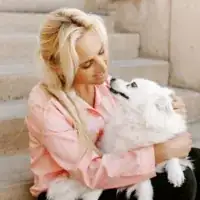 Natalie Punt, DVMDr. Natalie Punt is a Veterinarian and the Founder and CEO of mPet- a smart phone app for pet owners to store, manage and transfer their pets medical records and health information. She specializes in small animal emergency and general medicine and veterinary practice economics. Dr. Punt holds a BS in Biochemistry and Molecular Biology from The University of California, Davis, an MS in Biochemistry from The University at Buffalo, and a DVM from Western University of Health Sciences.
Natalie Punt, DVMDr. Natalie Punt is a Veterinarian and the Founder and CEO of mPet- a smart phone app for pet owners to store, manage and transfer their pets medical records and health information. She specializes in small animal emergency and general medicine and veterinary practice economics. Dr. Punt holds a BS in Biochemistry and Molecular Biology from The University of California, Davis, an MS in Biochemistry from The University at Buffalo, and a DVM from Western University of Health Sciences.
Veterinarian Keep her away from other male dogs if you don't plan on breeding her. There are certain types of diapers that might be helpful. If she displays certain types of behaviors like overly vocalizing or being clingy, focus on supporting until her hormones have resolved themselves.
Keep her away from other male dogs if you don't plan on breeding her. There are certain types of diapers that might be helpful. If she displays certain types of behaviors like overly vocalizing or being clingy, focus on supporting until her hormones have resolved themselves. -
QuestionShould a dog be groomed before giving birth?
 BleakyCommunity AnswerI wouldn't say this is entirely necessary, since your dog will most likely get their coat mussed up while in labor. But if you'd like, sure, although I would think grooming after the delivery would be a better option. A nice grooming may calm your pregnant mother if she enjoys being brushed.
BleakyCommunity AnswerI wouldn't say this is entirely necessary, since your dog will most likely get their coat mussed up while in labor. But if you'd like, sure, although I would think grooming after the delivery would be a better option. A nice grooming may calm your pregnant mother if she enjoys being brushed. -
QuestionHow much does it cost to get a dog pregnancy test?
 MarinaCommunity AnswerEvery veterinarian is different. In-clinic, you should expect around $100 USD, and $15-30 USD for over the counter options. You also have the option of requesting an x-ray instead of a pregnancy test for $25-65 USD, however this cannot be done during the late stages of gestation.
MarinaCommunity AnswerEvery veterinarian is different. In-clinic, you should expect around $100 USD, and $15-30 USD for over the counter options. You also have the option of requesting an x-ray instead of a pregnancy test for $25-65 USD, however this cannot be done during the late stages of gestation.
Expert Interview
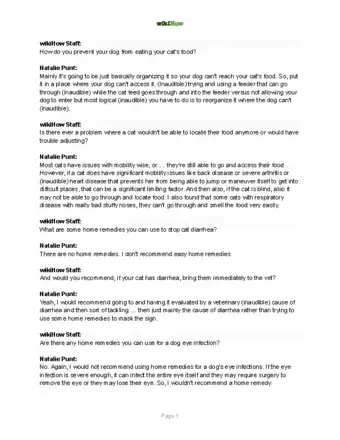
Thanks for reading our article! If you'd like to learn more about taking care of a dog, check out our in-depth interview with Natalie Punt, DVM.
